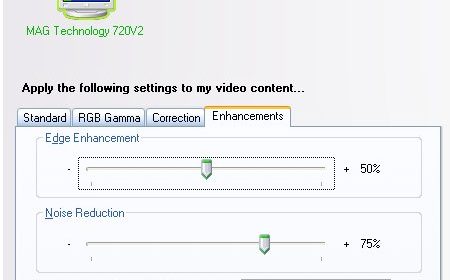HQV Benchmarking the GeForce 7-series

The HQV Benchmark DVD is probably the best and most objective video processing test available today. Unfortunately there are still subjective comparisons that need to be made to give a final rating. Of course reference images are given to compare against, and if you see something that has totaly failed it is obvious. The less obvious is when the scores allow a middle value: what does this middle ground look like? To answer this you need to have some real comparisons, say for example against a sampling of DVD players. I did this testing while working on my review of Oppo's new kick-butt DVD player.
General testing notes
In case you've been under a rock NVIDIA has made large strides in exposing PureVideo functionality at the display driver level and less tied into their own decoder filter (PureVideo Decoder). Thus having it work in basically the same manner as ATI's Avivo technology. What that means is that using ForceWare 91.47 or newer is the key to better deinterlacing and video post-processing. In the screenshot at the bottom of my post are the settings I used for testing. NVIDIA has done something rather stupid (ATI is just as guilty it turns out): they have Inverse Telecine support turned off by default! You must go into the new NVIDIA control panel choose 'Video & Television', then 'Adjust video color settings', and make sure you're in 'Advanced' view, click the 'Enhancements' tab and check 'Use inverse telecine'. Without this checked you won't be using the advanced PureVideo technology, leaving this unchecked will also lead to most video cadences failing miserably when the HQV test is run. Similarly, any detail enhancement or noise suppression technology is also off by default. You do get sliders to control the level of processing which is great for adjusting to personal taste. I found 50% for 'Edge Enhancement' and 75% for 'Noise Reduction' to be ideal for the passing the HQV tests.
| Â | GeForce 7-series |
| Color Bar/Vertical Detail (0/5/10) | Â 10 |
| Jaggies 1 (0/3/5) | Â 5 |
| Jaggies 2 (0/1/3/5) | Â 3 |
| Flag (0/5/10) | Â 5 |
| Picture Detail (0/5/10) | Â 10 |
| Noise Reduction (0/5/10) | Â 10 |
| Motion Adaptive Noise Reduction (0/5/10) | Â 10 |
| 3:2 Detection/Film Detail (0/5/10) | Â 10 |
| Film Cadences (8 different) (5 points each) | Â 40 |
| Mixed 3:2 with video titles horiz. (0/5/10) | Â 10 |
| Mixed 3:2 with video titles vert. (0/5/10) | Â 10 |
| Total (130) | Â 123 |
It's the little differences…
If you compare my chart to hardware.info's tests from 9/5/06 my scores have very similar results, however the hardware.info folks give the Flag a full 10 points which I don't think it deserves, the Oppo did better then what I've seen from PureVideo. Likewise Jaggies Test 2 is source of disagreement. It deserves a 3, Hardware.info which also tested against standalone DVD players agrees, Tom's Hardware's recent tests gave it a full 5, the Oppo did better on this test, I question whether Tom's really has seen modern video processing chips in action. Interestingly, like me, Hardware.info also arrives at a score of 123, they remove points in the Mixed 3:2 with Horizontal Video Titles which I don't think is deserved. They are also lenient with their score of the 3:2 Detection test giving it a 10. Using their settings this actually deserves a 5, Tom's testing corroborates this.
The PureVideo Decoder's 'Smart' SettingÂ
If you use a general DXVA decoder, such as PowerDVD or WinDVD, or set the PureVideo Decoder to 'Automatic' the 3:2 detection has an approximately 1/2 second lag. However when you use NVIDIA's own PureVideo Decoder in 'Smart' mode you don't even see the lag as it enters film mode. The lag means you get a 5 on this test. The testing procedures are quite clear: if the video processing locks on to film mode in under 0.2 seconds that's a 10, in 1/2 a second – that's a 5. Anything longer is a failure.
What I found interesting is that this seems to go counter to the recommendations Hardware.info has. They say to use 'Automatic', I presumed that somehow 'Smart' used different logic then 'Automatic' and it might disable the much improved cadence handling that NVIDIA now shows. So I tested this by running the tests in 'Automatic' and in 'Smart'. There is no difference to the scores aside from the very important 3:2 detail test. 'Smart' is incredible, it never even batted an eye. It looks like with the newest ForceWare builds the cadence detection is ready to be used by any DXVA decoder filter. However having the proprietary 'Smart' mode of the PureVideo Decoder sweetens the deal. NVIDIA's own decoder is considered to have the best image quality of any commercial DVD decoder product and added to this is the fact that it also has the unique deinterlacing mode — 'Smart'. Thus my scores presented here and in the upcoming Oppo review represent the 'Smart' mode scores.
HD Material
Interestingly, I found 'Automatic' performed properly with HD material while 'Smart' occasionally made odd hitching in HDTV playback. It looks like 'Automatic' is the middle-ground here if you watch a mix of both SD and HD or if you watch solely HD material.
Settings Used for Testing
Â
